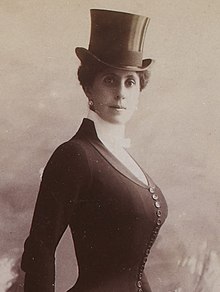Therese Renz

Therese Renz , b. Stark (born April 10, 1859 in Brussels , † September 29, 1938 in Berlin ), was a German art rider, tamer and circus director.
Life
Therese Stark was born as the daughter of the equestrian Lina Wunderlich and the circus director Wilhelm Stark and grew up in the circus until her father left her and her mother. Then she was supposed to be raised by an aunt on her mother's side who ran a cleaning and fashion shop in Wandsbek . This attempt ended after she attended a performance at the Renz Circus and convinced her mother and aunt that she had to seek her luck at the circus. At the age of almost 13 she was placed at the Wulff Circus, where she received extensive artistic training. She made her debut on April 10, 1873 in Solothurn as a standing rider. After a long tour through Germany and Switzerland, she switched to the Renz Circus, where she fell in love with the director's nephew. Ernst Renz discovered the relationship between Therese Stark and his nephew Robert (1843–1897) and dismissed the two because he had forbidden love affairs in the troupe.
Therese Renz now accepted an engagement at Circus Herzog , where Robert Renz had been employed since 1879. The young couple married on February 3, 1883. It was Robert Renz's second marriage; his first marriage in 1870 was an Italian woman named Laura Partenza.
In 1893 Therese Renz performed again in the Renz Circus, which was meanwhile run by Franz Renz , after which the family toured - in the meantime son Hugo had been born - with Therese Renz's mother through Europe. In 1904 Therese Renz traveled to the USA , where she performed for fourteen months in the New York Hippodrome.
After losing her mother, her husband and her son in quick succession, she initially wanted to withdraw into private life, but then founded her own circus, with which she initially traveled in Belgium . Therese Renz trained her animals herself, in addition to the horses she had always worked with, now also ponies, mastiffs and zebras. After the outbreak of World War I , her circus was boycotted in Belgium and went bankrupt . Therese Renz was left with only two Asian elephants , which she now began to train. She had great success with this - her favorite elephant Dicky even learned the “handstand” on a foreleg - but could not avoid the material hardship. After roaming Germany's streets with the elephants for some time, begging for food for the animals, one of the elephants died of malnutrition. Before this fate could also overtake Dicky, Therese Renz sold him to the Knie circus . Dicky was the first elephant in this circus.
In 1923 Therese Renz, now over 60 years old, made a comeback as a rider on her horse “Last Rose” at the Busch Circus in Vienna . For more than ten years she worked in the ring again; She celebrated her 75th birthday in Berlin at Scala with a performance by the high school . In her acceptance speech, she expressed the hope that she would still be able to celebrate her 80th birthday in the saddle.
She continued to travel Europe; Her cousin Lina Wunderlich and her groom Otto were with her, as they had for many years. Lina Wunderlich died around 1937. Therese Renz followed her a little later. She was buried in Berlin in the St. Hedwigs Friedhof , where her husband's grave was also located.
literature
- Franz Xaver Dworschak, master of the ring circus people, tell from their lives , Zeitgeschichte-Verlag, Berlin 1943
- Stephanie Haerdle, do n't be afraid, that's our job! Art riders, trainers and other circus performers , Berlin 2007, ISBN 978-3-932338-29-8 , pp. 50–56
Web links
Individual evidence
- ↑ The names Lina Wollschläger - probably after the foster father Eduard Wollschläger - and Louis Stark are also often given.
- ^ Alfred Etzold: The Dorotheenstädtische Friedhof: the burial places on the Berlin Chausseestrasse . Ch. Links Verlag, 1993, ISBN 978-3-86153-058-9 , p. 165.
- ↑ A statement deviating slightly from this often given date makes the artistism and its history . International Phonetic Artis literature publishing, Willy Backhaus, 1910, p.22 .
- ↑ Artism and its history . International-Artistic Literature Verlag, Willy Backhaus, 1910, p. 22.
- ↑ Eléphants chez Knie (1920–2016): historique on sites.google.com
- ↑ Fernando Offermann, In Search of the Princes , in: Berliner Zeitung , July 28, 1994 ( online )
- ^ Alfred Etzold, Wolfgang Türk: The Dorotheenstädtische Friedhof: the burial places on Berlin's Chausseestrasse . Ch. Links Verlag, 2002, ISBN 978-3-86153-261-3 , p. 90.
| personal data | |
|---|---|
| SURNAME | Renz, Therese |
| ALTERNATIVE NAMES | Stark, Therese; Renz-Stark, Therese; Renz, Thérèse; Starck, Therese; Renz-Starck, Therese |
| BRIEF DESCRIPTION | German rider, tamer and circus director |
| DATE OF BIRTH | April 10, 1859 |
| PLACE OF BIRTH | Brussels |
| DATE OF DEATH | September 29, 1938 |
| Place of death | Berlin |